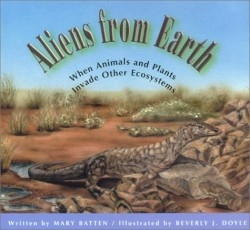
Aliens from Earth
When Animals and Plants Invade Other Ecosystems
The best science books for children are grounded in young people’s backyards and lead children around the globe and to new understandings of how the natural world works. This accessible ecology book for readers ages eight to twelve does all of these things. The author, an award-winning science writer for children, introduces young readers to the problems caused by invasive animal and plant species, also known as exotics.
She tells the stories of the accidental and deliberate introduction of several plants and animals that disrupted or destroyed their new habitats: wild cats that ate some of Australia’s marsupials into extinction, zebra mussels throughout the Great Lakes, malaria-bearing mosquitoes that killed off several species of Hawaii’s most famous birds, Japanese kudzu covering the forests of the American south, and Caulerpa, an aquarium algae that now covers more than 10,000 acres of the Mediterranean seabed and poisons the eggs of many small fishes. Batten weaves definitions of key ecological concepts-like ecosystems, predators, and biodiversity-throughout these real-life stories, making them easily understood for young readers.
The colorful, realistic illustrations depict animals and plants in their native and new habitats interacting with one another. At the bottom of each image is a key that names the species and its role in that ecosystem, as alien, native, endangered, or extinct. The key is remarkably simple and understandable and adds to the accessibility of these rather complex concepts for young children. Several illustrations map the world travel routes of alien species. As a result of these and Batten’s stories, children will learn history and geography as well as ecology.
In the end, Batten focuses on people’s responsibility to maintain the delicate balance of the world’s ecosystems and its rich biodiversity. All of her stories of aliens show the culpability of humans, as in our arrogance and ignorance we have attempted to adjust the webs of life that are our ecosystems, or as we accidentally carry species from one place to another in our travels by air, land, and sea around the globe. Batten ends her book with a wonderful list of ideas that children (and adults) can use to minimize their impact on their own environments at home and when they travel.
Reviewed by
Kate Husband
Disclosure: This article is not an endorsement, but a review. The publisher of this book provided free copies of the book to have their book reviewed by a professional reviewer. No fee was paid by the publisher for this review. Foreword Reviews only recommends books that we love. Foreword Magazine, Inc. is disclosing this in accordance with the Federal Trade Commission’s 16 CFR, Part 255.
